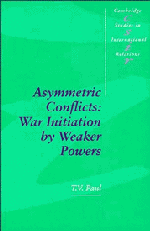Conclusion
Published online by Cambridge University Press: 03 May 2011
Summary
In Chapter 2, I outlined the major hypotheses pertaining to war initiation in asymmetric conflicts. The hypothesized relationships between war initiation and the four variables – strategic calculations of the belligerents, changes in short-term offensive capability, great power alliance relationships, and domestic power structure – were also elaborated. The arrival of these factors has been hypothesized to have causal connection to the choice for war by states that hold inferior aggregate capability vis-à-vis their opponents.
In subsequent chapters, these hypotheses were tested in the light of six historic cases of asymmetric war initiations. The following matrices show the approximate level of presence of the variables for the chosen cases at the time when war was being considered. Table 1 rates the presence of these factors in cases when war initiation actually occurred. Table 2 similarly rates the variables when war initiation was considered but did not take place. The variables are rated for each case on a numerical scale of 0 to 10, where 0 indicates no presence of that variable and 10 denotes a very strong presence.
In the six cases that I have explored in this study, the first factor – strategic calculations, based on a limited aims/fait accompli strategy – seems to be of major significance in explaining the phenomenon of asymmetric war initiations.
- Type
- Chapter
- Information
- Asymmetric ConflictsWar Initiation by Weaker Powers, pp. 167 - 178Publisher: Cambridge University PressPrint publication year: 1994



